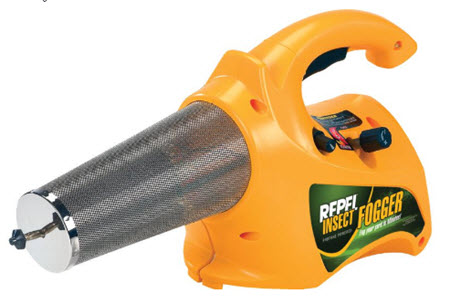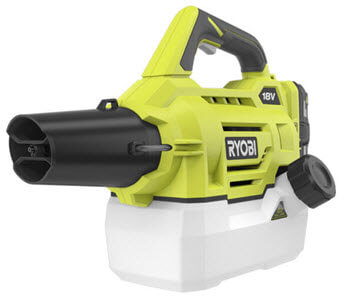You may be looking to kill some troublesome mosquitoes, so you can use your yard for at least a few hours and are thinking about buying a fogger.
Fogging is very efficient at killing insects, including mosquitoes, but there are different types of foggers. You may have heard the terms thermal fogger and ULV cold fogger but aren’t sure of the differences or what you need.
While they both have the same aims, the process of producing the fog is different. They use distinct fogging insecticides and can be used for other tasks.
Let’s see if we can find what would be best for you.
Thermal Foggers
Thermal foggers use heat to vaporize an insecticide solution and propel the vapor as a visible fine fog. There are two types of thermal foggers – propane and electric. As these foggers produce heat they are not recommended for use indoors.
Propane Thermal Foggers

These foggers use a propane cylinder to provide the heat to vaporize the liquid solution used in the treatment.
The cylinder is attached to the rear of the fogger; the valve is turned on. An igniter creates a spark when actioned, which ignites the gas. The combustion of the fuel heats a coil. The trigger, which is usually in the handle, pumps the fogging solution from the storage tank to the coil. As the liquid passes through the coil, it heats up and turns into a fog emitted through a nozzle.
Before using a thermal fogging machine, it has to heat up for at least 2 minutes. When you are fogging, you can control the fog’s wetness by the rate of pumping.
Pumping (pressing on the trigger) once every 3 or 4 seconds should give dense white fog, which is ideal for mosquito control. If you notice the fog is thin or yellowish, it means you are pumping too slowly. On the other hand, if the fog is wet and the fogger is dripping, it means you’re pumping too fast.
The droplet size for fog emitted by thermal fogging equipment can be in the range of 0.5 – 10 microns.
Electric Thermal Foggers
An electric thermal fogger machine works in a similar way to gas foggers, but they use electricity to heat the barrel. When you press the trigger, an electric pump forces the fogging liquid through a nozzle and into the heating chamber in the barrel. The chemical is vaporized, and a cloud of thermal fog is released.
Most electric foggers have a valve that adjusts the amount of insecticide pumped into the heating chamber when you press the trigger. This allows you to produce a drier or wetter fog. An electric fogger also has to pre-heat for at least 2 minutes.
The big downside with an electric fogger is that it needs to be connected to an electric supply for it to work. The cord on the device is normally only one foot long, so you will need a long extension cable to treat a big garden and then drag it around behind you.
Use of Thermal Foggers
Thermal foggers produce tiny droplets and a visible fog which makes them ideal for insect control.
- the smaller droplets from 10-15 microns, which is the optimum size for mosquito control, stay suspended in the air longer and penetrate dense vegetation better
- the visible fog makes it easier to direct the fog more accurately and for the operator or bystanders to avoid the fog
Cold Foggers
A cold fogger can be used indoors and outdoors to treat pests, disinfect, treat mold and unpleasant odors. They are called cold foggers as they don’t use any heat to produce the fog. They use large volumes of cold air at pressure to transform a liquid solution into droplets. ULV foggers are the most common cold foggers.
ULV Electric Foggers
ULV stands for ultra-low volume. As the name suggests, they use less insecticide than thermal foggers. The droplets produced by ULV foggers can be set precisely and varied by the operator, making them more versatile.
Inside the cold fogger is a motor that draws the liquid from the storage tank to a special nozzle. The nozzle splits the liquid into tiny droplets and is propelled from the fogger under pressure created by the motor. As these foggers are powered by electricity, you will have an extension cable to pull around with you if used in a large garden.
The droplet size on most ULV foggers can be adjusted from 5-50 microns, although some foggers for different uses have a droplet size of 5-100 microns. This is very useful as different sorts of treatments use different droplet sizes. For example:
- mosquitoes, anything from 5-25 microns is very near the optimal size
- disinfectants use different size droplets depending on whether you are treating air-borne pathogens under 10 microns or for surface pathogens 10-40 microns or 40-100 microns
ULV Battery Foggers

These work in the same way as the electric ULV foggers, only it’s easier to move about with them as there is no cable. They can also be used where there is no electricity supply. You will have about 45 minutes of use with a handheld battery ULV fogger with a charging time of about 4 hours. This could be perfect for a small area.
ULV Backpack Foggers
If you have a large garden, then a backpack fogger could be what you need. You will be able to treat your whole garden without having to refill. This can save time and stop you from being exposed to the insecticide when you refill your fogger.
The backpack foggers are powered by a gasoline motor or batteries and can have a large storage tank taking 3 gallons or more. Having a large capacity sounds really practical but consider the weight. When full of insecticide, gasoline, and the machine’s weight, this can easily total over 60lbs.
Use of Cold Foggers
ULV foggers can also be used to combat mosquitoes; the droplets produced may be slightly larger, so they won’t stay in the air quite as long, but they are still effective. When fogging with a ULV fogger, the fog is nearly invisible, making it harder to see where the fog has reached and avoid the mist for operators and bystanders.
Apart from mosquitoes, ULV foggers are more versatile and can be used for a number of applications pesticides, fungicides, herbicides, disinfectants, and odors. Because they don’t produce heat, they can be used indoors as well as outside.
What’s Best For You?
It depends on what you will be treating. If it’s mosquitoes in your yard, a thermal fogger will be great. But if you have a large garden, a propane fogger will be more practical. Thermal foggers produce a fog with smaller droplet sizes. These smaller droplets stay in the air longer and are more effective at killing mosquitoes.
However, for a large garden of several acres, I would go for a backpack fogger.
For interior usage, there is a fire risk with thermal foggers. Therefore, if you want to use your fogger outdoors for insect control and indoors for disinfection, odor control, or to treat mold, a ULV fogger is your best bet.
DIY fogging isn’t the only solution, professionals also provide mosquito control services. Depending on the time and expertise you have it may be a solution you prefer.

